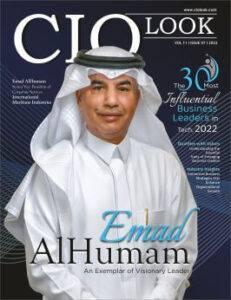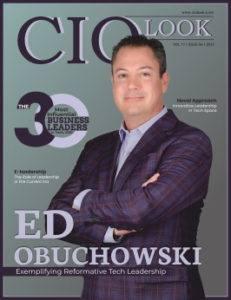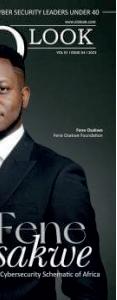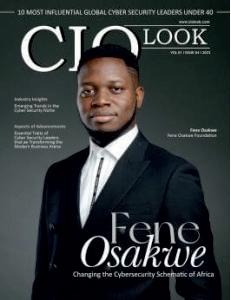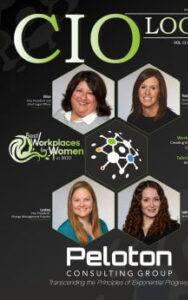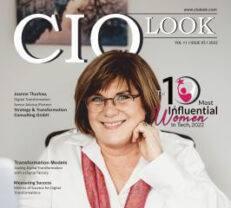








Educationalleadershipplaysacriticalroleinshaping
the future of learning environments and driving meaningful improvements across education systems. It involves the vision, strategies, and actions of individuals in leadership roles, such as school administrators, policymakers, and academic leaders, who work to cultivate a culture of excellence, equity, and continuousgrowth.Effectiveeducationalleadershipextends beyond the administrative management of institutions. It includesinspiringeducators,supportingstudents,engaging withcommunities,andfosteringinnovationtoensurethatall learners have access to high-quality educational experiences. One exemplary figure in this field is Richard Larson, whose contributions to education have made a lastingimpactonmillionsoflives.
CIOLook in its recent edition titled 2025’s Rising Star of Educational Leadership in America highlights Larson’s career as a powerful example of the lasting impact of education as a lifelong endeavor. From his academic beginnings at MIT to his groundbreaking contributions in

operations research and model-based thinking, Larson has consistently demonstrated that learning extends far beyond the classroom. His passion for teaching was not limited to lectures; he found profound fulfillment in mentoring graduate students and supporting collaborative research. Eveninretirement,Larsonremainsadedicatedadvocatefor intellectual curiosity His recent work, including the book MODEL THINKING for Everyday Life, seeks to make analyticalthinkingmoreaccessibletoawideraudience.
Personal trials, including early teaching challenges and the lossofhiswifeandcollaborator,Liz,haveonlydeepenedhis resilience and commitment. Together, they championed globalaccessSTEMeducationthroughinitiativeslikeMIT BLOSSOMS Today, Larson continues to engage with emerging technologies, particularly AI, advocating for its ethical integration into learning environments. His legacy endures not only in academia but also in the lives, communities, and innovations he has inspired across the globe.
Haveagreatreadahead!
























A Lifelong Journey in Learning and Crea�ng an Impact
Lifelong Learning Redefining Academic Leadership for Future Genera�ons


Leadership Reimagined The Rise of Innova�ve Academic Leaders
PoojaMBansal Editor-in-Chief
CONTENT
Deputy Editor Anish Miller
Managing Editor Prince Bolton
DESIGN
Visualizer Dave Bates
Art & Design Director Davis Mar�n
Associate Designer Jameson Carl
SALES
Senior Sales Manager Wilson T., Hunter D.
Customer Success Manager Nelson M.
Sales Execu�ves Tim, Smith
TECHNICAL
Technical Head Peter Hayden
Technical Consultant Victor Collins August,
Research Analyst Eric Smith
SEO Execu�ve Alen Spencer
FOLLOWUSON


www facebook.com/ciolookmedia/ www.x.com/ciolookMedia
www.linkedin.com/company/ciolook
WE ARE ALSO AVAILABLE ON
CONTACTUSON
Email info@ciolook com
For Subscrip�on www.ciolookmedia.com
Copyright © 2025 CIOLOOK, All rights reserved. The content and images used in this magazine should not be reproduced or transmi�ed in any form or by any means, electronic, mechanical, photocopying, recording or otherwise, without prior permission from CIOLOOK. Reprint rights remain solely with CIOLOOK.





















































MIT
Professor


RichardLarsonhasspentalifetimedemonstratingthe
transformative power of education. His professional andpersonaljourney spanningacademia,research, mentorship,andinnovation embodiesthebeliefthatlearning is not merely an academic pursuit, but a lifelong endeavor QuotingB.B.King,“Thebeautifulthingaboutlearningisthat noonecantakeitawayfromyou,”Larsonstandsasaliving testament to this sentiment. His contributions to operations research, education models, and decision sciences have not onlyshapedhisfieldbutalsoinfluencedthousandsofminds globally
Even after retiring from formal teaching, Larson continues to explore, educate, and engage His passion for model-based thinking,hiswriting,andhisunwaveringcuriosityaffirmthat intellectual pursuit doesn't retire with age it evolves. Through every phase of his life, he has blended intellectual rigor with a deeply humanistic approach, making learning accessibleandrelevanttoall.
Thisnarrative,sharedinhisownreflectivewords,isnotjusta recount of achievements but a narrative of purpose of how one man’s commitment to learning, integrity, and service continues to ripple across disciplines, classrooms, and communities. Richard Larson’s legacy is not confined to books or lectures. It lives in the minds he’s influenced, the innovations he’s inspired, and the future he continues to shape.
Larson’s academic journey began with a pivotal milestone beingacceptedtoMITasafreshmanattheageof 18 after graduating from Needham High School. Though his fatherhopedhewouldcommutetomanageexpenses,Larson’s path took a different shape when he joined the Phi Beta Epsilon fraternity, located right on Memorial Drive, on campus.Thefraternityofferednotjusthousingbutavibrant intellectual and emotional community that enriched his experienceatMIT.
This early exposure to a stimulating and collaborative environment deeply influenced Larson’s development Surroundedbybrightmindsandacultureofinquiry,hefound the perfect platform to refine his passions What began as a curiosity for technical subjects soon matured into a commitment to research and problem-solving that would definehisprofessionallife.
This phase culminated in his pursuit of a PhD in Operations Research Whenhisfacultyadvisor,ProfessorAlvinW Drake,
extended an unexpected invitation to join the MIT faculty, Larsonhesitated.Grapplingwithwhathetermedthe“Groucho Marx syndrome,” he questioned whether he was ready for such responsibility so soon after being a student himself. Ultimately,hisdecisiontoacceptmarkedthebeginningofa long,impactfulacademiccareer
Teaching,forLarson,becamemorethanaprofession itwasa sourceofjoyandpurpose Whilehevaluedlecturing,hismost profoundsatisfactioncamefromguidinggraduatestudents He formedcloseacademicrelationshipsthatfosteredacultureof creativity,collaboration,andbreakthroughresearch.
Heoftenspeaksofthepridehefeltwatchingstudentstransition from learners to innovators and thought leaders. These relationships went beyond simple mentorship they were intellectual partnerships that sparked new ideas and nurtured rigorousinquiry
Larson never saw education as a one-way transmission of knowledge Hevieweditasaninteractiveprocesswhereboth teacher and student learned from each other. His classrooms wereplaceswherecriticalthinkingflourished,andhislegacyis carried forward by the countless students who now shape fieldsfromacademiatoindustry
In recent years, Larson has dedicated himself to making complex concepts accessible to the general public. His book, MODEL THINKING For Everyday Life,isthecornerstoneof this mission. It breaks down abstract academic models and reframesthemaseverydaytoolsforbetterthinking,decisionmaking,andproblem-solving.
“Larson never saw educa�on as a one-way transmission of knowledge. He viewed it as an interac�ve process where both teacher and student learned from each other.”





Hisbeliefisstraightforward:modelshelppeopleunderstandthe world.Whethermanagingtime,navigatingpersonalchoices,or leading teams, conceptual models serve as valuable cognitive frameworks By equipping people with these tools, Larson hopestodemocratizeanalyticalthinking,helpingindividuals livemoreinformedandempoweredlives.
Eveninretirement,hispassionremainsundiminished.Rather than stepping away from learning, he has simply shifted his audience fromgraduatestudentstoglobalcitizenseagerfor wisdomthattranscendsdisciplines
Larson’sintellectualcuriosityknowsnobounds Hefrequently invokes Einstein’s saying, “A day without learning is a day wasted.”Forhim,learningisnotconfinedtoformalsettings it happens everywhere, from observing animal behavior to solvingresearchproblemsinhissleep.
Infact,someofhisbreakthroughsemergedduringsleep,such as insights that led to his influential Hypercube Queueing Model, used to improve urban emergency response systems These episodes affirm his belief that the subconscious mind, when nurtured by curiosity, continues working to solve problemsevenatrest.
This perspective learning as a lifestyle rather than a stage underscores his entire career For Larson, every day offersanewopportunitytounderstand,question,andinnovate
Larson’s influence isn’t limited to MIT. Through his involvement with Notre Dame Cristo Rey High School and other educational causes, he has worked to extend learning opportunities to students from underserved backgrounds. His vision is clear: access to education should not be a privilege butarightforanyonestrivingforabetterfuture.
One of his most enduring legacies is the endowment of the Larson Chair in Data, Systems, and Society at MIT. This initiative ensures ongoing research and education in fields criticaltomodernchallenges ItisatestamenttoLarson’slongtermthinkingandbeliefininstitutionalcontinuity—ensuring thatinnovationcontinueslongafterhisowncareer
This philanthropic act reflects a man who doesn’t just teach values butlives them.His contributions continuetoempower educatorsandresearchers,ensuringtherippleeffectoflearning neverceases




“Even in re�rement, his passion remains undiminished. Rather than stepping away from learning, he has simply shi�ed his audience—from graduate students to global ci�zens eager for wisdom that transcends disciplines.”
No journey of excellence comes without trials Early in his academiccareer,Larsonfacedahumblingexperiencewhen,as agraduateteachingassistant,hewasunabletoclearlyexplain anequationtoastudentduringalecture.Thatmomentrevealed tohimtheresponsibilityeducatorscarryandtheimportance ofmasteryinteaching.
Fromthenon,hecommittedtodeeppreparationbeforeevery lecture Theexperienceinstilledinhimadisciplinethatshaped his teaching style and reinforced his own learning. This vulnerability and growth mindset became hallmarks of his character—transforming setbacks into stepping stones for excellence.
Hisstoryservesasavaluablereminderthatchallengesarenot roadblocksbutcatalystsforbetterment.
At the heart of Larson’s journey was his partnership with his wife, Mary Elizabeth Murray (“Liz”). Married for 43 years, their relationship was built on shared values, intellectual collaboration, and mutual respect. Liz was not only his emotionalanchorbutalsoanactivepartnerinhisprofessional life.
ShemanagedtheMITBLOSSOMSinitiative,whichaimedto providefreeSTEMeducationresourcestohighschoolstudents around the world. Together, they traveled widely, delivering

presentations and building global educational networks. One poignant memory was Liz speaking confidently to a packed audience in SaudiArabia, embodying their shared vision of accessibleeducation.
Even outside MIT, Liz supported Larson’s consulting firm, ENFORTHCorp.Herpassingnearlytwoyearsagoleftadeep void, but her influence continues through their shared contributionsandthelivestheytouchedtogether
StayingUpdatedinaRapidlyEvolvingWorld
Although retired, Larson keeps a close eye on technological trends especiallytheriseofArtificialIntelligence.HeseesAI as both a powerful educational tool and a challenge. He is concernedaboutAI’simpactonacademicintegrity,asstudents increasinglyrelyontoolsthatautomatelearning.
Larson urges institutions to use AI responsibly, focusing on maintaining intellectual engagement and fostering human creativity.HebelievesAIshouldenhancelearning,notreplace thecognitiveprocessofdiscovery.
As the world undergoes rapid transformations in technology, culture, and global interconnectivity, the landscape of higher education is shifting in tandem Traditional models of academic leadership, once built around hierarchical structures and administrative authority, are increasingly ill-suited for the complexities of the modern educationalenvironment.Inthiscontext,redefiningacademic leadership for future generations is not simply a desirable evolution but a necessary strategic imperative Leaders in academiamustadapttonewchallengesbyfosteringinclusivity, embracinginnovation,andcultivatingaresilientanddynamic institutional culture Academic leadership today requires a departure from the status quo. The skills that once defined success, such as administrative efficiency or disciplinary specialization, are no longer sufficient in isolation. Futureready academic leaders must act as visionaries and collaborators who understand how to integrate interdisciplinary knowledge, leverage digital tools, and respond proactively to societal needs This transition demandsintentionaleffortsinleadershipdevelopment,policy reform, and the creation of more participatory governance models.
EmbracingInnovationandTechnologicalFluency
One of the most significant transformations in academic leadershipisthegrowingemphasisontechnologicalfluencyAs digitaltechnologiesreshapetheeducationalexperience,leaders must be capable of navigating and leveraging these tools to enhance learning outcomes, research productivity, and institutional operations. This goes beyond merely adopting online learning platforms It includes data-informed decisionmaking, fostering digital literacy across the institution, and promoting an ethos of experimentation with emerging technologies Leaders must also ensure equitable access to



















digital resources, especially as the digital divide continues to impactunderservedstudentpopulations.
Innovation should not be confined to technology alone Academic leaders must also promote pedagogical innovation that reflects diverse learning styles and incorporates experiential and problem-based learning strategies In this respect, leadership means enabling faculty development, revisiting outdated curricula, and encouraging crossdisciplinary collaboration. These changes help position universitiesasagile,forward-thinkinginstitutionsthatnurture creativityandadaptabilityinstudents Byredefiningleadership toincludetheresponsibilityoffosteringinnovation,academic institutionscanremaincompetitiveandsociallyimpactfulina rapidlyevolvinggloballandscape
A redefined vision of academic leadership must also place strong emphasis on inclusivity and ethical stewardship Institutions of higher education are becoming increasingly diverseintermsofstudentdemographics,facultybackgrounds, andglobalpartnerships Asaresult,leadershipmodelsrootedin uniformityorexclusivityarenolongerviable.Futureacademic leadersmustdemonstrateculturalcompetence,empathy,anda commitment to social justice. These values are essential for buildingtrustwithintheacademiccommunityandforcreatinga learningenvironmentwhereallindividualsfeelseen,heard,and valued
Inclusive leadership also involves rethinking governance and decision-makingprocesses.Ratherthanoperatingintop-down silos,academicleadersmustadoptsharedgovernancemodels that engage a wider range of stakeholders. This includes students, adjunct faculty, administrative staff, and community partners Transparent communication and collaborative planningfosteracultureofmutualaccountabilityandrespect Ethicalleadershipfurtherdemandsthatdecisionsaremadewith integrity,balancingfinancialsustainabilitywiththeinstitution’s academic mission and societal responsibilities. In doing so, leaders can help build academic institutions that serve as beaconsofequityandmoralclarityinacomplexworld.
BuildingResilienceandAdaptiveCapacity
Perhapsthemostpressinglessonfromrecentglobalchallenges such as the COVID-19 pandemic is the need for academic institutions to develop resilience. In this context, academic leadershipmustfocusonbuildingstructuresandmindsetsthat can withstand disruption while remaining aligned with core
educational values. Resilience is not merely about surviving crisesbutaboutlearningfromthemandusingthoseinsightsto fostercontinuousimprovement Thisrequiresleaderswhocan operate under uncertainty, make timely yet thoughtful decisions,andcommunicateeffectivelyunderpressure
Adaptiveleadershipiscloselylinkedtoresilience Asthepace of change accelerates, academic leaders must be comfortable withambiguityandcommittedtolifelonglearningthemselves. They must create environments where innovation is encouraged,failuresareviewedaslearningopportunities,and adaptability is embedded into institutional culture Strategic foresight, scenario planning, and investment in leadership developmentprogramsareallessentialtoolsinthisendeavor By embedding resilience and adaptability into the core of academic leadership, institutions will be better positioned to meettheevolvingexpectationsofstudents,faculty,andsociety atlarge.
Redefiningacademicleadershipforfuturegenerationsinvolves more than revising job descriptions or reorganizing departments. It requires a profound shift in values, competencies, and institutional structures. Effective leaders mustbetechnologicallyfluent,ethicallygrounded,inclusivein their approach, and resilient in the face of uncertainty As educationcontinuestoevolveinresponsetoglobalshifts,the capacity of academic leaders to guide their institutions with visionandintegritywilldeterminetherelevanceandsuccessof higher education in the decades to come. The future calls for leaderswhoarenotonlyadministratorsbutalsochangeagents, ready to shape a more inclusive, innovative, and resilient academicworld.












































Intherapidlyevolvinglandscapeofglobaleducation,
academic leadership is undergoing a significant transformation Traditional roles focused primarily onadministrativeefficiencyandacademiccomplianceare givingwaytomoredynamic,forward-thinkingleadership approaches Innovativeacademicleadersareemergingas pivotal figures in shaping the future of education by integrating creativity, technology, and collaboration into institutionalframeworks.Theirriseisnotsimplyashiftin leadershipstylebutaresponsetotheincreasingcomplexity of challenges facing educational institutions worldwide Fromaddressingdigitaldisruptiontoenhancingdiversity, theseleadersaredrivingchangebyreimaginingpedagogy, curriculum development, and institutional culture Their emphasis on adaptability, inclusivity, and continuous learningreflectstheneed for higher education to remain relevantandresponsiveinaninterconnectedworld.They areredefiningwhatitmeanstolead,inspiringconfidence among stakeholders and embracing bold strategies. As universities and colleges confront funding constraints, globalization,andrisingstudentexpectations,innovative leaders are proving to be vital in ensuring institutional sustainabilityandacademicexcellence.
One of the key characteristics of today’s innovative academicleadersistheirabilitytoarticulateacompelling vision for the future These leaders are not content with maintainingthestatusquo;instead,theyanticipatechange and proactively position their institutions to thrive amid uncertainty. Visionary leadership in academia involves recognizing global trends, such as digital transformation and interdisciplinary research, and aligning them with institutionalgoals Thiskindofleadershipismarkedbya
strategicmindset,thecouragetochallengeoutdatedpractices, andacommitmenttolong-termimpact.
Leaders with a forward-looking vision also empower faculty andstudentstobecomeagentsofchange Byfosteringaculture of innovation and experimentation, they create environments where new ideas can flourish These academic leaders champion initiatives that encourage cross-departmental collaboration, industry partnerships, and community engagement. They invest in leadership development and mentor future changemakers As a result, institutions under suchleadershiparemoreagileandbetterequippedtoaddress societal needs, produce relevant research, and cultivate graduateswhocansucceedinarapidlychangingjobmarket
Inthedigitalage,theabilitytoharnesstechnologyeffectively has become a hallmark of innovative academic leadership These leaders understand that technology is not merely a support tool but a strategic asset that can redefine teaching, learning, and administration From implementing online learning platforms to using data analytics for student success, they integrate digital solutions to enhance institutional performanceandstudentoutcomes.Theirapproachisgrounded inthebeliefthateducationshouldbeaccessible,personalized, andfuture-ready
Data-driven decision-making is another key feature of innovative academic leadership. Leaders are increasingly relying on institutional data to inform policies, improve operationalefficiency,andidentifyareas forgrowth.Whether analyzingenrollmentpatterns,monitoringstudentengagement, or evaluating program effectiveness, data enables leaders to make informed choices that align with institutional missions They also use predictive analytics to anticipate challenges beforetheyarise Byleveragingtechnologyanddataintandem, academic leaders can foster continuous improvement and accountability while ensuring that their institutions remain competitiveinaglobaleducationmarket.
Innovative academic leaders recognize that inclusive and collaborative cultures are essential for institutional success Theyactivelyseektocreatelearningenvironmentsthatrespect diverse perspectives and promote equity at all levels. This involvesnotonlyrecruitingandretainingadiversefacultyand student body but also embedding inclusive practices in curriculum design, research agendas, and governance
structures.Suchleadersunderstandthatdiversityisastrength thatenhancescreativity,criticalthinking,andproblem-solving withinacademiccommunities
Collaboration is another central pillar of their leadership philosophy By breaking down silos and encouraging interdisciplinary cooperation, these leaders facilitate more robustacademicandadministrativeoutcomes.Theyoftenactas connectors, bringing together stakeholders from different backgroundsanddisciplinestoworkonsharedgoals.Whether throughcross-institutionalpartnerships,jointresearchprojects, or collaborative teaching models, they champion collective innovation Theireffortsalsoextendtoalumniengagementand global networks In doing so, they help institutions navigate complexitywithresilienceandfosterastrongsenseofshared purpose.
The rise of innovative academic leaders signals a new era in highereducation,onedefinedbyagility,vision,andarelentless driveforimprovement Theseleadersarereshapinginstitutions by embracing change, championing diversity, and leveraging technology to create meaningful learning experiences. Their efforts are not only elevating academic standards but also ensuring that higher education remains a vital force in addressing societal challenges As the demands on academic institutionscontinuetogrow,theimportanceofsuchleadership will only increase Future academic leaders must draw inspiration from these trailblazers, cultivating the skills and mindset necessary to lead in uncertain and complex environments.Bydoingso,theywillcarryforwardalegacyof innovation that ensures the relevance and resilience of educationintheyearstocome.



































